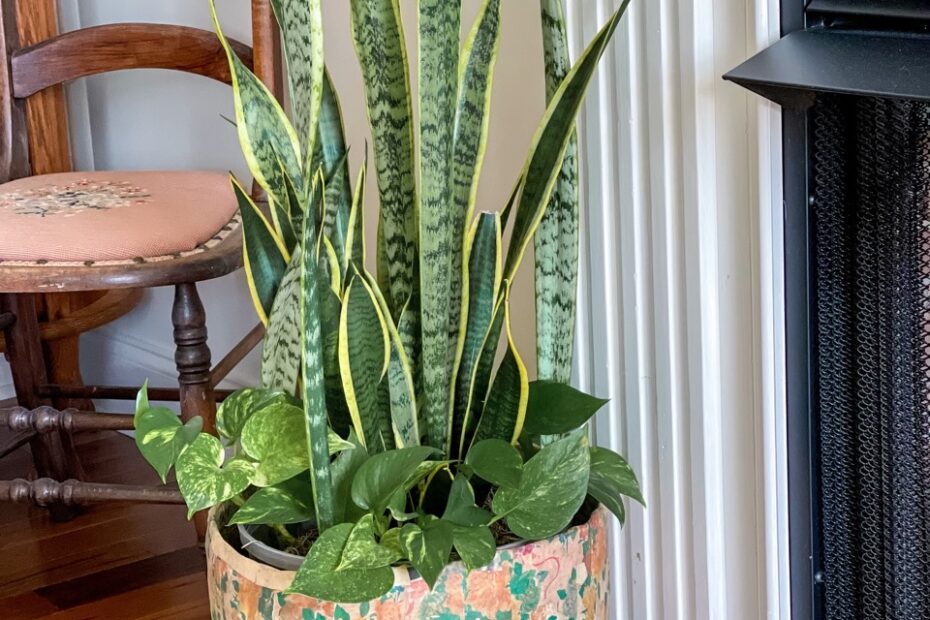
In the dimly lit corners of our homes, there exists a humble hero standing tall amidst the shadows, quietly cleansing the very air we breathe. A steadfast companion that requires minimal care and exudes an air of timeless elegance – the snake plant. While it gracefully thrives in its compact form, many plant enthusiasts yearn for their green companion to reach for the stars. If you too aspire for your snake plant to grow to towering heights, fear not! In this article, we shall embark on a botanical journey, unveiling the secrets to unlock the untapped potential within your beloved snake plant. With a touch of patience, dedication, and a sprinkling of green magic, you’ll soon witness your once modest snake plant transform into an illustrious beacon of nature’s grandeur. So, let us not waste another precious moment and delve into the enchanting world of serpent-like foliage, as we discover how to make snake plants grow tall.

Choosing the Right Pot and Soil for Optimal Growth
When it comes to making your snake plant grow tall, one of the most important factors to consider is choosing the right pot and soil. The pot you select and the type of soil you use can have a significant impact on the overall growth and health of your snake plant.
First and foremost, you’ll want to choose a pot that has adequate drainage. Snake plants prefer well-draining soil, so it’s essential to select a pot with drainage holes at the bottom. This will allow excess water to escape, preventing the soil from becoming waterlogged and potentially causing root rot. Additionally, opting for a pot with a diameter that is slightly larger than the current size of your snake plant will allow it room to grow.
| Feature |
Tips |
| Soil type |
Choose a well-draining soil mix specifically formulated for snake plants. Avoid heavy and compact soils. |
| Pot material |
Consider using a ceramic or terracotta pot as they provide better airflow to the roots and help regulate moisture levels. |
| Size |
Select a pot that allows for some room for growth without being excessively large. A slightly bigger pot is ideal for a mature snake plant. |
Equally important is the choice of soil for your snake plant. It is best to opt for a well-draining soil mix that is specifically formulated for snake plants. This type of soil will allow for proper airflow and prevent excessive moisture retention, which can lead to root rot. Avoid using heavy or compact soils that tend to hold onto water for extended periods.
Consider using a pot made of ceramic or terracotta rather than plastic or glass. Ceramic and terracotta pots provide better airflow to the roots and can help regulate moisture levels. Additionally, these materials are more aesthetically pleasing and can add a touch of style to your indoor space. Remember to select a pot size that allows for some room for growth but isn’t excessively large, especially for a mature snake plant. Giving your snake plant a slightly bigger pot will encourage healthy growth and prevent overcrowding of its roots.

Loading... Seconds Left for
Miniature Orchid Terrarium Gallery!

Maintaining Ideal Light Conditions for Snake Plant
Snake plants are known for their striking appearance and ability to thrive in a variety of light conditions. However, if you want your snake plant to grow tall and healthy, it’s important to maintain ideal light conditions. Here are some tips to help you create the perfect lighting environment for your snake plant:
-
I
ndirect sunlight: Snake plants prefer bright but indirect light. This means placing them near a window where they can receive filtered light throughout the day. Avoid exposing your snake plant to direct sunlight, as it can burn the leaves and cause damage.
-
Avoid dark corners: While snake plants are resilient, they still require some level of light to grow properly. Keep your snake plant away from dark corners of your home where natural light is scarce. Instead, choose a well-lit spot that receives moderate levels of indirect light.
>To help you maintain the ideal light conditions for your snake plant, here are some features and tips to consider:
| Feature |
Tip |
| Temperature |
Keep your snake plant in a room with temperatures between 60°F-85°F (15°C-29°C), as extreme temperatures can affect its growth. |
| Artificial lighting |
If your snake plant doesn’t receive sufficient natural light, you can supplement it with artificial grow lights to ensure it gets the necessary light it needs to thrive. |
| Rotate the plant |
To ensure even growth, rotate your snake plant every few weeks to expose all sides to light and prevent leaning towards the light source. |
By providing your snake plant with the right amount of light and maintaining ideal conditions, you can encourage healthy growth and allow it to reach impressive heights. Remember to monitor your plant’s response to light and make adjustments as needed to ensure its overall well-being.

Snake plants are known for their striking appearance and resilience, making them a popular choice for indoor gardening enthusiasts. However, if you want your snake plant to be truly show-stopping and grow tall, it’s important to implement proper watering techniques. By understanding how to water your snake plant correctly, you can ensure its optimal growth and health.
First and foremost, it’s important to note that snake plants have a unique watering requirement. These plants prefer to dry out between waterings, so it’s crucial to avoid overwatering. Overwatering can lead to root rot and various other issues that can hinder your plant’s growth. To prevent this, follow the guidelines below:
- Use well-draining soil: Snake plants thrive in well-draining soil that allows excess water to flow out easily. Opt for a potting mix specifically designed for cacti and succulents, or create your own by mixing equal parts of regular potting soil, perlite, and sand.
- Water sparingly: Snake plants have low water needs. Depending on the size of your plant and the environmental conditions, water your snake plant only once every 2-4 weeks. Before watering, always check the moisture level of the soil by inserting your finger about an inch or two in. If the soil feels dry, it’s time for watering.
- Avoid wetting the leaves: To prevent fungal issues, it’s crucial to avoid wetting the leaves when watering your snake plant. Instead, water directly at the base of the plant, aiming for the soil. This will help maintain the plant’s overall health and vitality.
By implementing these proper watering techniques, you can give your snake plant the best chance at growing tall and flourishing. Remember, snake plants are naturally adaptive, so even if you encounter some setbacks, don’t lose hope. Take note of their individual watering needs and adjust accordingly. Happy planting!
>
| Features or Tips |
|
| Well-draining soil |
✓ |
| Watering sparingly |
✓ |
| Avoid wetting the leaves |
✓ |
When it comes to helping your snake plant reach new heights, pruning and propagation techniques can be invaluable. These tips will guide you on how to make your snake plant grow tall and encourage vertical growth.
Pruning Tips:
- Remove any yellow or brown leaves to promote healthier growth.
- Trim off any leggy or drooping stems to maintain an upright appearance.
- Consider cutting back overgrown foliage to stimulate new growth from the base.
Propagation Tips:
- Choose a healthy, mature snake plant with multiple stems for propagation.
- Cut a healthy leaf at least 3-4 inches from the base to create a cutting.
- Allow the cutting to dry for a day or two before planting it in well-draining soil.
| Features |
Tips |
| Increase sunlight exposure |
Place your snake plant near a bright window for at least six hours a day. |
| Proper watering |
Avoid overwatering and allow the soil to dry between waterings. |
| Fertilize regularly |
Use a balanced houseplant fertilizer every two months during the growing season. |
Frequently Asked Questions
Q: Can my snake plant touch the ceiling and become a real-life “snake”?
A: While snake plants (Sansevieria) can grow quite tall, they won’t slither around like a serpent! With proper care, your snake plant can reach impressive heights, adding a touch of jungle magic to your home.
Q: How do I feed my snake plant to encourage its growth spurt?
A: Well, if it starts asking for a burger, you might need to check if your plant came to life! But joking aside, snake plants actually thrive on neglect. They don’t need much nutrition and can survive in low-light conditions. Just water sparingly and let their sturdy nature do the rest.
Q: Can snak
e plants grow tall enough to serve as a natural room divider in my home?
A: Absolutely! Snake plants come in different varieties, some of which can reach heights of several feet. With their striking vertical foliage, they make excellent room dividers, adding both greenery and privacy. Just place them in a large, decorative pot and watch them grow tall and elegant. As we conclude this verdant journey through the secrets of snake plant growth, remember that patience and care are the keys to reaching new heights. Just like the steady ascent of a mountaineer conquering the peaks, our leafy friends too require steadfast nurturing to flourish.
By tending to their needs with love and attention, you become their guiding light, coaxing them to unfurl and reach towards the sky. Delight in the subtle dance of the sunlight embracing their emerald leaves and witness the marvelous transformation of an insignificant sprout into a towering beauty.
While the strategies shared in this article may seem simple, they hold immense power to catapult your snake plant into a realm of towering magnificence. From finding the perfect location for optimum light exposure to mastering the art of watering, each step is a vital ingredient in the recipe for success.
Embrace the
journey and relish the connective bond formed with your beloved snake plant. Marvel at its resilience as it overcomes obstacles and stretches towards the heavens. Cherish the fresh oxygen it provides and the enchanting touch of nature it brings into your living space.
So, dear plant enthusiasts, as you embark on this botanical adventure, keep in mind that every leafy comrade requires unique care. Observe, experiment, and adapt, for it is through the nurturing hands of an avid gardener that these magical creatures truly thrive.
May your snake plant stand tall with elegance, a testament to your dedication and nurturing spirit. Remember, with a little patience and a green thumb, the sky’s the limit for these emerald guardians of serenity and joy.
Hello! I'm Jessica Owen, an avid gardener and proud contributor to Up-Gardening.com. Gardening is my passion, and I'm delighted to share my green-thumb experiences with you. From planting tips to nurturing blooms, I'm here to help you cultivate your own slice of paradise. Let's grow together in the garden!
Latest posts by Jessica Owen
(see all)v>
<
!-- CONTENT END 1 -->




